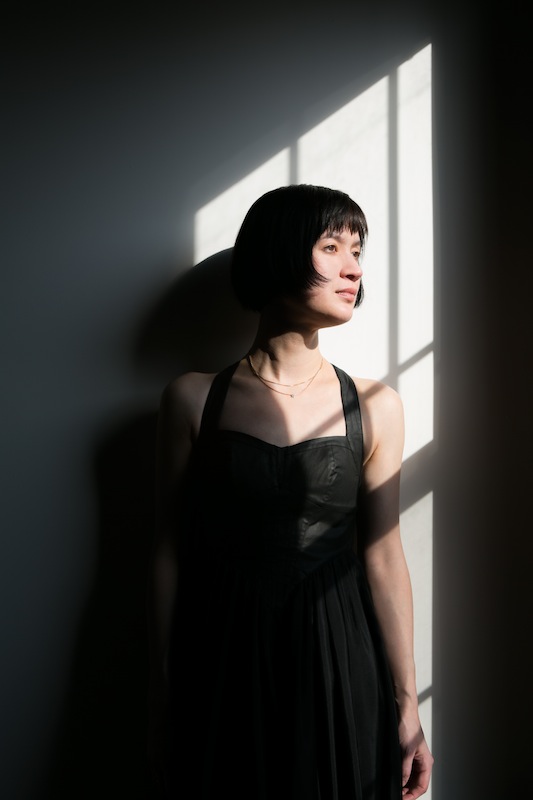Cuckson, Sorey and friends wrap Look and Listen Festival with enlightening program

Violinist Miranda Cuckson performed at the Look and Listen Festival Sunday night. Photo: Beowulf Sheehan
The 14th annual Look and Listen Festival concluded Sunday at the Whitebox Art Center with a concert of new music that featured the performers as much as the composers. In roughly three sets, interspersed with interviews from WQXR radio host Terrance McKnight, listeners had the close-up experience of what some contemporary composers are producing, and one musician’s large-scale view of modern music.
That musician was the excellent violinist Miranda Cuckson, who played four works, three of them solo pieces. Also playing were the duo of percussionist Jason Treuting and Jeffrey Ziegler, and drummer Tyshawn Sorey’s Trio. Treuting and Sorey played their own compositions, Cuckson was an interpreter.
All the pieces she played were originally suggested by her, before the festival made the final programming decisions. It’s fair to say she played what mattered to her, and so the program reflected not only her skill as a musician but her judgment as an artist. Both put her in the top rank of contemporary musicians.
She opened the concert with Shulamit Ran’s Inscriptions, a terrific piece that builds off the 19th-century legacy of the violinist as solo star. In three movements, the music explores some of the classic flavors of violin playing—the infernal (with a quick, cheeky quote from L’Histoire du soldat), dance music, and the pure structuring of music through melodic lines and arpeggiated chords.
This was a great display for Cuckson, and the fine, resonant acoustics of the Whitebox space. Her sound was rich and weighty yet exact and full of color; she played everything with a clear idea of how she wanted the music to go.
Cuckson played a sequence of three works, beginning with Franco Donatoni’s Ciglio III, with pianist Cory Smythe. Both musicians tackled the antiphonal short, rhythmic vibrant phrases as if involved in a game, then joined together in more homophonic passages to reach energetic heights. Solo again, Cuckson finished with Xenakis’ Mikka S, and Kaija Saariaho’s Nocturne. Xenakis’ etude based on double-stopped glissandos is face-melting, and Cuckson shredded it, at one point producing triads through difference tones. She also created an unexpectedly lovely sound from Saariaho’s set of melodic phrases and mournful timbres.
The other major contributor to the concert was drummer and composer Tyshawn Sorey, one of the most unique and outstanding of contemporary musicians.
Sorey is primarily known as one of the leading drummers in jazz, where he has made enormous and vital contributions to an ongoing revolution in jazz rhythm. He is also a considerably exciting composer of through-composed music at the leading edge of the Western classical tradition. At the Whitebox center, he played some of his most recent work with his current trio, with Smythe and bassist Christopher Tordini.
Sorey has established a compositional voice that is intuitive and rigorous. His music is often quiet, full of space, expressive, and beholden to neither harmonic resolution nor atonality—his work seems like a logical extension of Webern and Morton Feldman. The instrumentation is that of the classic jazz piano trio, and Sorey’s music seems to constantly search for an almost song-like expression, while using harmonies that mix familiar voicing with surprising movement—think of Schumann as played by the Bill Evans Trio.
The musicians played an excerpt from Movement, a substantial piece from Sorey’s exceptional 2014 album, Alloy (Pi Recordings). This is a ballad, led by the piano, with bass and drums adding plangency and color. Sorey writes with great skill for the piano, and Smythe clearly relished feeling the phrases and harmonies flow under his hands.
The group concluded the concert with two excerpts, “Allegro” and “Blues,” from a new work title Minutiae. The music makes space for improvisation, though not jazz, closer to John Zorn’s technique of fully notating a cadenza-like part, then having other instruments improvise along with it. From exciting, energetic music—Tordini made some strong statements—the music elided with a contemplative, mysterious piano part, a blues not in terms of a scale or set of chords but in the feeling of sehnsucht. The absence of formal resolution was perfectly satisfying for music that is in the middle of carving out its own place in the universe.
Treuting—a member of So Percussion—and Ziegler played music by Ziegler’s wife, Paola Prestini, and the world premiere of Treuting’s Block and Line. Prestini’s Quiet was an often lovely meditation on memory, with an audio track that carried comforting sounds of home. But it also carried the music’s flaw, an intrusive, artificial, sequenced rhythm that was a misfit for the overall aesthetic.
Block and Line was, as Treuting described, a pairing of vertical and horizontal music, the first an expanding and contracting snare roll set against a sustained cello tone, the second an exercise in shifting rhythms, tempos and meters. It left the feeling that it needed a final section, but was finely made and finely played.


